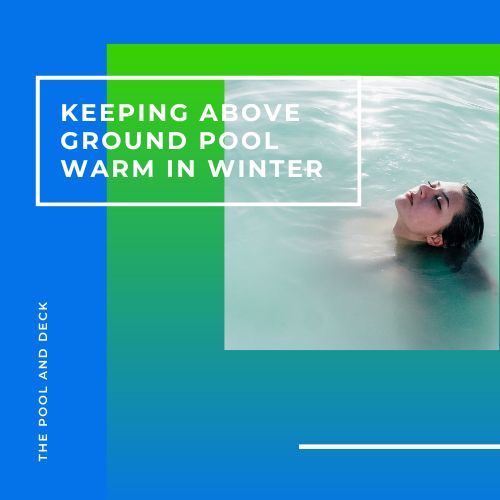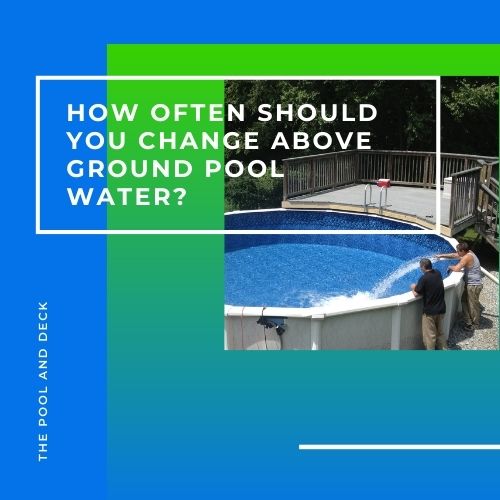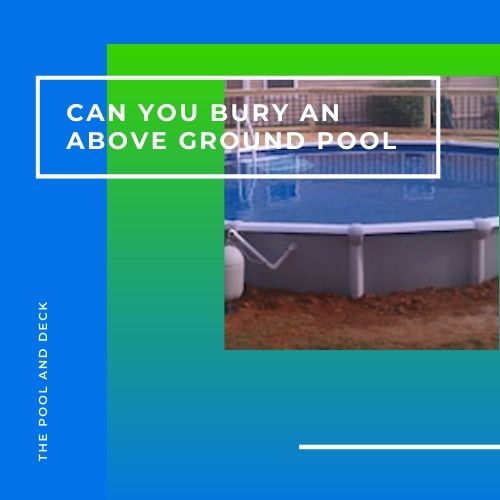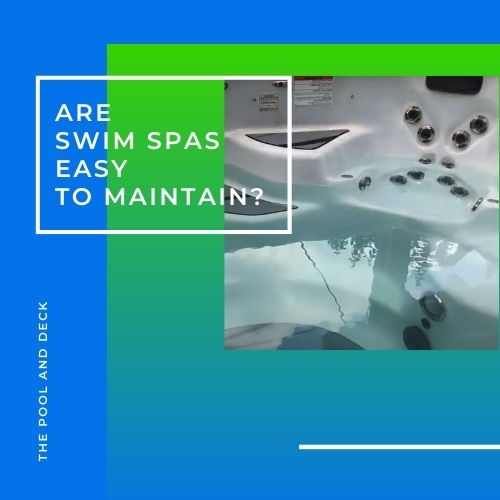7 Absolutely Great Ways to Keep an Above Ground Pool Warm in Winter!
As an Amazon Associate, I earn from qualifying purchases.
Having invested a reasonable sum of money in your above ground pool, you certainly want to make the most of it. However, the number of days the water will be warm enough for a comfortable swim, will be limited. More so if you live in one of the colder climatic zones. So you may ask, “How do I keep my above ground pool warm in winter”?

There are 7 absolutely great ways to keep your above ground pool warm in winter. The list is as under:
- Gas Fired Pool Heater
- Electric Resistance Pool Heater
- Wood Burning Pool Heater
- Solar Powered Pool Heater
- Heat Pump Pool Heater
- Solar Pool Cover
- Protect the Pool from Wind
1. Gas Fired Pool Heater
Gas Fired Pool Heaters are among the most popular ways of keeping an above ground pool warm during winter. If you are wondering how to heat an above ground pool quickly then a Gas Fired Pool Heater is the answer.
A Gas Fired Pool Heater is a great choice if you use your pool occasionally during winter. You can heat up the pool only when you need to swim. It is also one of the better options if you live in a cold climate where you may not get enough sunlight in winter.
The heater runs on propane or natural gas. So you need to hook it up to a backyard propane tank or a natural gas supply pipeline.
The heater is added to the pool circulation system after the pump and the filter. Heat is generated in the heater by burning gas. The heated water goes back to the pool.
A Gas Fired Pool Heater is not the most cost effective or energy efficient option, but it gets the job done fast. To save operating costs, buy a model that has high efficiency.
The US Department of Energy estimates that a 95% efficient model could save you over 40% in energy costs as compared to a 55% efficient model.
2. Electric Resistance Pool Heater
Electric Resistance Pool Heater works in the same way as a Gas Fired Pool Heater. The only difference is the source of energy. The advantage of an electric heater is that the energy source is the same as the pool pump and other accessories such as pool lights, etc.
Electric Resistance Pool Heaters are easier to install. The electrician who hooks up the pool pump can also hook up the pool heater.
Electric heater for an above ground pool is, however, not as fast or as efficient as a gas fired pool heater, particularly in colder climates. The electricity consumption for family size above ground pool is so high as to make it an impractical option.
3. Wood Burning Pool Heater
Wood Burning Pool Heaters may sound very old school and traditional, but they are still effective. You can not order Wood Burning Pool Heaters online or get them from stores such as Home Depot or Lowes. You need to get them custom-made. Alternatively you can even make it yourself as a DIY project.
The process of heating the pool water in a Wood Burning Pool Heater is exactly the same as a Gas Fired or Electric Resistance Pool Heater. The only difference is that you burn wood for heating.
A Wood Burning Pool Heater is a great option if you already use wood stoves to heat your house. It is ideal for keeping a hot tub, spa or a small above ground pool warm in winter.
4. Solar Powered Pool Heater
A Solar Powered Pool Heater works like any pool heater, except that it harnesses the energy from the sun, which is free. It is the most cost effective way to keep your above ground pool warm in winter.
The only caveat is that you must be living in a zone which has plenty of sunlight during the day.
The design of the Solar Powered Pool Heater can vary. For larger pools, rectangular solar panels, similar to those meant for house roofs, are used. For smaller pools, dome shaped Solar Powered Pool Heaters are more convenient.
The pool water, after filtration, is passed through the Solar Powered Pool Heater. A Solar Powered Pool Heater can raise the temperature of the pool water, by as much as 15° F.
The Mega SolarDOME works with your existing pool filter system. Using your existing filter system, water circulates through the solar panel, is heated by the sun and returns to the pool through the filter system raising your pool’s temperature up to 15 degrees.
5. Heat Pump Pool Heater
A Heat Pump Pool Heater works by taking the heat from the surrounding air and transferring it to the water in the pool. The principle on which a Heat Pump Pool Heater works is exactly the same as that of an air conditioner. The Heat Pump Pool Heater just works in reverse.
The warm outside air is drawn into the Heat Pump Pool Heater using a fan. The warm air passes over an evaporator coil with cold liquid refrigerant. The refrigerant absorbs the heat and becomes a gas. The warm gas is further heated up by running it through a compressor. The hot gas is used to heat the pool water.
Heat Pump Pool Heaters have a high initial cost but are cheaper to run than gas powered or electric resistance pool heaters. A pool Heat Pump can operate even in temperatures as low as 45° F to 50° F.
Of course, the efficiency of a Heat Pump Pool Heater drops when the outside temperature drops. As such, a Heat Pump Pool Heater is ideal for keeping small above ground pools warm in early winter.
A Heat Pump Pool Heater will warm up your above ground pool sufficiently for a comfortable swim even when it may be somewhat chilly outside.
Compare prices of an Electric Heat Pump Pool Heater and Natural Gas Pool Heater for an above ground pool.
HEAT PUMP
GAS FIRED
An Electric Heat Pump Pool Heater will keep your above ground pool warm in mild winter. However, for winters where temperatures drop to 40 – 45 degrees F, you are better off with a Gas Fired Pool Heater.
6. Solar Pool Cover
A Solar Pool Cover does not actually warm up the above ground pool, but it prevents heat loss when the outside temperature drops in winter, especially at night.
A Solar Pool Cover is different from other types of pool covers that are used for safety or to prevent debris from falling into your pool. A Solar Pool Cover is made of a plastic sheet with air bubbles, much like a bubble wrap.
A Solar Pool Cover, therefore, has high thermal insulation properties. It prevents heat loss from the pool. A Solar Pool Cover can be used, along with a pool heater, to keep your above ground pool warm in winter, more efficiently, at a lower cost.
Apart from insulation, a Solar Pool Cover also reduces heat loss from the pool by reducing water evaporation. As an added benefit a Solar Pool Cover keeps bugs and debris out of the pool too!

24′ Round 12 Mil Clear Solar Pool Cover – $164.99
from: Pool Splash, LLC
A Solar Pool Cover can also be in liquid form. Liquid Pool Covers, cover the pool surface with a non-toxic, alcohol based liquid. This thin layer is completely safe for swimmers and saves energy by trapping heat & reducing evaporation. They are super convenient and cheaper too!
Check out TROPICAL FISH LIQUIDHEAT SOLAR BLANKET. Unlike a conventional pool blanket which has to be removed before swimming can begin, LiquidHeat breaks apart whenever the water is disturbed but when the water becomes calm, LiquidHeat regroups to reform the protective layer.
7. Protect the Pool from Wind
Evaporation from your above ground pool results in
- Loss of Water
- Loss of Pool Chemicals
- Loss of Pool Heat
The evaporation rate from an outdoor pool varies depending on the pool’s temperature, air temperature and humidity, and the wind speed at the pool surface.
US Department of Energy
Pool covers are the best way to reduce water evaporation and contain the pool water, chemicals and heat.
High wind speed over the surface of the pool water increases the rate of evaporation. Since you cannot keep the pool covers on, all the time, you should consider adding windbreaks.
Strategically added windbreaks can help keep your above ground pool warm during winter.
Adding a solid or a semi solid fence around the above ground pool, will not only reduce the wind speed over the water, it will also provide some privacy.
Alternatively you can use natural or artificial shrubs or trees. They add beauty to the landscape, while reducing air flow over the pool surface.
Thank you very much for reading the post. I do hope you found it informative and helpful.






